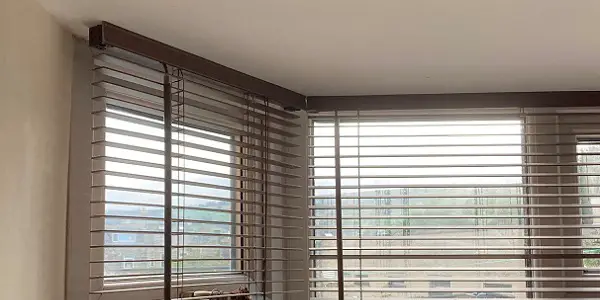The DIY Fix is reader supported. When you buy after clicking a link on our site, we may earn an affiliate commission.
Condensation is the most common form of damp in the average British home. It is often found on windows behind blinds and curtains.
This is because every single household constantly produces moisture and humidity. This comes from a variety of places. These include:
- Bodily functions – As humans we are constantly releasing moisture into the home via our breath and sweat.
- Using the bath or shower – A hot bath or a hot shower can produce a large amount of steam.
- Cooking – Again this is a regular task, and it can produce a lot of steam, which will increase the average humidity in your home.
Once this water vapour is in the air, it will move around the home until it finds a surface to condense on.
Warm moist air is naturally attracted to a cold surface. This is known as a dew point, and it is the reason we often wake up to our windows covered in condensation.

Windows tend to be much colder surfaces than the surrounding walls. As soon as warm water vapour hits the cold surface, it condenses back into liquid water which we know as condensation.
Windows with blinds can suffer more with condensation. Especially if the blinds are regularly down, as moisture can become trapped behind them. This is due to less circulation behind the blind.
Also, because most blinds pull down, it is easy to miss signs or damp and mould at the top of windows where the blinds are fixed. This can be particularly true if the blinds are fitted inside the window reveal or somewhere like a bay window.
This problem is not likely to happen with curtains as they open sideways, and you will usually have full visibility behind the curtain.
How do you stop condensation behind blinds?
There are many things you can do to reduce condensation behind your blinds. However, your main goal should be to reduce relative humidity. Relative humidity is the percentage of moisture in the air.
At 100% humidity the air would be completely saturated and unable to hold any more water.
High humidity in a home is anything above 60%. At this level, the air is carrying too much moisture, and will look to deposit this on colder surfaces.
A comfortable range of relative humidity for humans, is between 40-50%, this is also an acceptable level for our homes. Ideally you would try and keep to the lower end in winter as the window surfaces will be colder. This means that moisture will condense at a lower relative humidity.
If you lower the amount of condensation on your windows, this will make damp and mould behind blinds far less likely.
You can also track the relative humidity with a Hygrometer. This is essentially a thermometer that measures humidity. Hygrometers are quite cheap (usually between £10-£20), so it makes sense to have one or two around the house. This helps you to keep an eye on the humidity and take action if it gets too high.
3 ways to reduce condensation behind your blinds
As we have already mentioned, lowering humidity is key, but how do we do that? Below are 3 simple ways to reduce condensation on windows and behind window blinds.
- Open windows – This is the cheapest and easiest way to improve airflow in your home and especially around your blinds. Obviously, this is less appealing during winter months. However, it is still advised if you are doing something that creates a lot of moisture.
For example if you are cooking or bathing, you should really open a window during the process. This will allow the steam created to escape. - Use an extractor fan – If you don’t want your window open, then one obvious solution is an extractor fan. These can be installed in high moisture areas, such as kitchens and bathrooms
You will need an electrician for installation, but the fans are relatively cheap and can be fitted in the day. So, you essentially have the cost of the fan and the day rate for an electrician. - Get a dehumidifier – This is probably the easiest option as it doesn’t need a skilled tradesperson to install, and it will mean you don’t need to open your windows. The dehumidifier can be set to reach a certain level of humidity.
Most decent models can be set to automatically turn on once ideal humidity is exceeded. This is great because you maintain a nice level and the dehumidifier is only on when reducing humidity. This means it doesn’t waste electric and is very energy efficient.
You can see our favourite dehumidifier here
Other things to do include checking behind your blinds, if you notice any damp and condensation wipe them away with cloth or paper towel. Also make sure to treat any signs of mould with a simple DIY mold spray.
Conclusion
Condensation is a nuisance, and it can go unnoticed, especially when it is hidden behind your blinds.
Window blinds aren’t necessarily bad for condensation. However, due to the way they are fitted, it can make condensation, damp, and mold more difficult to spot. This is especially true if your blinds are left down, or partially down for long periods of time.
By far the best way to reduce condensation behind blinds, is to lower your homes relative humidity. If there isn’t excess moisture in the air, then condensation will stop. This is true, regardless of whether blinds are fitted or not




